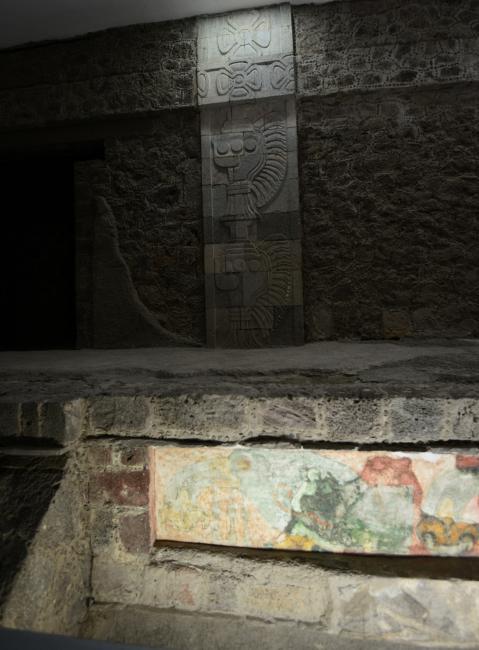
Templo de los Caracoles Emplumados
Estructura
In this precinct there is a pyramidal base built with walls in slope and board, in whose facades are represented several birds in procession distributed in four polychrome boards. In front, in a little explored space, a building decorated with red disks can be observed. On this base is shown the almost complete facade of a temple with representations in bas-relief of flowers of four petals and great feathered snails, figures that are painted directly on the rock.
Board with bird: There are four elements that conform the main figure of this mural, located in the Temple of the Feathered Snails. The first is the bird itself, the second is a band divided into three sections that continues the extension of the beak and represents a stream of water, the third are drops descending from a stream, and the fourth is a yellow flower at the end of the band.
The bird is green, outlined with black. It is painted on a red-orange background and spread horizontally; it has the appearance of a macaw or parrot because of its large, strong, hooked beak that opens to reveal the tongue. Above and behind the eyes, short and wide feathers delimit the perimeter of the head; on the body two sections of feathers are distinguished: the short ones are of the wings and are framed at the bottom by a sinuous band, which ends in a scroll and underlines the base of the wing, while the long ones of the tail are extended horizontally.
The band or stream, which exits behind the bird, is broad and is divided into three parallel sections extending in a curved manner between the bird's beak and the three-petaled flower. The upper and lower sections are dark green, the middle section shows traces of highly degraded light green. At the level of the curvature of the band there are three semi-oval shapes, possibly “water eyes”. The flower seen in profile has three petals, similar to a fleur-de-lis; the central petal is directed upwards like a spearhead with a rounded vertex, and the lateral ones curve to the sides. It is bordered at the top by a narrow green band and at the base by a short horizontal band in the shape of a crescent moon.
Fuente, Beatriz de la (coord.), 1995, La pintura mural prehispánica en México Teotihuacán, volume I, Mexico, UNAM/IIE.





